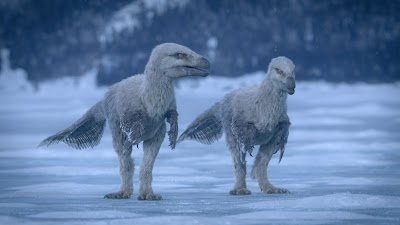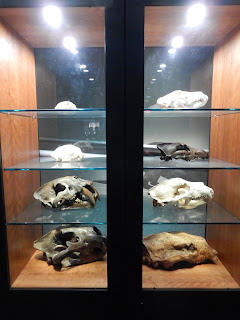To the delight of many, Prehistoric Planet came back this year for a second season. Much of the praise that was lavished on the first season is equally applicable to this one, so I think it's fair to cut to the chase and dive into the specifics of its maniraptoran portrayals. Season 2 follows its predecessor in focusing on life during the Maastrichtian Age of the Late Cretaceous, and with this setting comes a whole cast of both new and returning maniraptoran taxa.
One of these returning maniraptorans is the oviraptorosaur Corythoraptor from the Nanxiong Formation of China, this time shown in a nesting colony. From an aesthetic standpoint, I'm very much a fan of the Corythoraptor model in this series, so it was fantastic to see it get some airtime besides becoming tyrannosaurid chow. This segment was also a great opportunity to showcase the relatively large amount of data we have on oviraptorid reproduction. Sharp-eyed viewers might notice that the Corythoraptor eggs have a rough surface texture composed of numerous tubercles and are arranged in multiple superimposed, partially buried rings with their narrower ends pointing outward and inclined downward, all of which are traits that have been observed in preserved oviraptorid nests. The narration informs us that male Corythoraptor are responsible for tending to the nests, a behavior that has been suggested for oviraptorids based on several lines of evidence. The posture of the nesting Corythoraptor and the presence of a central opening in the nest for them to sit in are also inspired by known oviraptorid specimens.
 |
A Corythoraptor inspects its nest.
|
There are a few details in this depiction that may be controversial. One scene shows a Corythoraptor moving one of its eggs to a different spot in the nest, but it has been argued that most Mesozoic pennaraptorans likely did not manipulate their eggs after they were laid. In fact, a few studies have disputed the popular idea that oviraptorids incubated their own eggs at all, primarily on the basis of their nest architecture, though recent experimental evidence indicating that such eggs would have still benefited from the body heat of a parent and the absence of any obvious alternative means of incubation currently suggests to me that some level of contact incubation in these dinosaurs is more plausible. I was surprised that the Corythoraptor eggs were not colored blue-green following the inference of such coloration in eggs referred to Heyuannia. This is not a demonstrable inaccuracy (as egg coloration can be highly variable in closely related modern birds), but it seems like the type of scientific detail that Prehistoric Planet has otherwise fallen over itself to include.
Like nest-guarding animals of today, the Corythoraptor in the show have to contend with potential nest raiders. There is an irony to oviraptorids (once interpreted as specialist
"egg thieves") being shown suffering from egg predation themselves. In this case, the main threat that appears is the dromaeosaurid Kuru, an unexpected choice given that this dinosaur was named in 2021 (almost certainly well into the production of the series) and is not known to have occurred at the same locality as Corythoraptor, instead having been discovered in the Barun Goyot Formation of Mongolia. I wasn't particularly bothered by this—if these taxa overlapped in time (which is a possibility given that the ages of many Upper Cretaceous fossil-bearing rock units in Asia are far from well constrained), it's entirely plausible that they had geographic ranges larger than their current fossil record would suggest. The Kuru is depicted using the cover of darkness to target the Corythoraptor nests, likely based on evidence from scleral ring anatomy that some dromaeosaurids, including the closely related Velociraptor, may have been primarily nocturnal.
Speaking of Velociraptor, it is another returning face from the first season. In this season's outing, a family of Velociraptor are portrayed using steep terrain to their advantage while hunting the pachycephalosaur Prenocephale. It's a nice sequence that further showcases the potential diversity of hunting strategies in dromaeosaurids, and includes some cute baby Velociraptor to boot. New to the series (and to paleontology documentaries in general, as far as I'm aware) is the bizarre giant unenlagiine dromaeosaurid Austroraptor from the Allen Formation of Argentina, which is shown preying on fish, as has been hypothesized based on its long snout containing numerous conical teeth.
 |
An Austroraptor dismembers a gar.
|
The final dromaeosaurid genus to appear in this season is Pyroraptor from southeastern France, with a few juveniles briefly showing up on a shoreline to eat some stranded ammonoid larvae. I'll admit, it did enter my head that Asteriornis* would have been an excellent fit for the geographic location and ecological role demanded by this scene, but I understand that reusing the existing juvenile dromaeosaurid model was undoubtedly much easier for the filmmakers than designing an entirely new animal for such a minor part.
*I'd originally assumed that Asteriornis, having been described in 2020, did not have a chance of being included in either season of Prehistoric Planet. However, the second season does extensively feature the Malagasy mammaliaform Adalatherium, which was described about a month after Asteriornis was.
Moving away from dromaeosaurids (probably), this season also depicts Imperobator from the Snow Hill Island Formation of Antarctica. Imperobator was a large paravian of unclear affinities, and unlike dromaeosaurids, its second toe on each foot was not specialized for being raised off the ground, which Prehistoric Planet portrays correctly. In one scene, several Imperobator are shown as though they were filmed using a thermal imaging camera, and later on, the group attempts to hunt the ornithopod Morrosaurus. Coincidentally, the events in this segment bear some resemblance those of to a fan-made storyboard sequence by Denver Humphries and Ilari Pätilä.
 |
A pair of Imperobator catch their breath on the surface of a frozen lake.
|
Troodontids are represented in a couple of scenes. Several individuals investigate a fresh Alamosaurus carcass, but, consistent with studies on the structure and wear patterns of troodontid teeth, they are unable to penetrate its thick hide until a Tyrannosaurus opens it up. That troodontids coexisted with these larger dinosaurs is not in doubt, given that their teeth have been found in the Ojo Alamo Formation (or Kirtland Formation, depending on your terminology) of the southwestern United States. Pectinodon from the Lance and Hell Creek Formations further north appears in a separate segment, in which a group visits an alkaline lake to feed on swarms of brine flies, a behavior probably inspired by some extant gulls. The Pectinodon family here consists of a male and its offspring, reflecting the fact that male parental care has been inferred in troodontids for the same reasons that it has in oviraptorids.
Not content with only the flies as a food source, the adult Pectinodon is shown preying on some other paravians that have gathered at the lake, a flock of presbyornithids. An unusual decision was made here to refer to the presbyornithids by a name that has yet to be formally published, originally used for some undescribed pectoral girdle bones from the Hell Creek Formation. Regardless, the anatomy of the presbyornithids, like that of essentially all the other prehistoric animals in the show, is depicted very solidly. Details such as the webbed feet and the flattened, hook-tipped bill lined with keratinous plates for filter feeding were evidently referenced from more completely known Cenozoic presbyornithid fossils. In the interest of full disclosure, I should mention that conversations I've had with Darren Naish, the main scientific consultant on the series, were used to inform these presbyornithid restorations. So that's my informal and infinitesimally minuscule contribution to Prehistoric Planet, and I'm relieved that I no longer have to keep the existence of Season 2 a secret!
 |
The flamingo-duck's smile.
|
Having said that, my most severe criticism of this season concerns this segment. After the presbyornithids are introduced, the narration follows up with, "Dinosaurs, are here, too" as an segue to the arrival of the Pectinodon, thus implying that the presbyornithids are not also dinosaurs! This is not only flat-out inaccurate, but not mentioning that birds are themselves a group of dinosaurs seems like a major missed educational opportunity, especially considering that Prehistoric Planet has not shied away from showing non-avialan dinosaurs with bird-like appearances and behaviors (including in this very same segment). Darren has hinted that wording more explicitly recognizing the dinosaurian nature of birds was met with pushback from other forces during show production, which I think is incredibly unfortunate given that Walking with Dinosaurs had no issue with referring to avialans as "flying dinosaurs" in 1999.
That's not to end on a dour note, however. There is one more maniraptoran featured in the series left to discuss: the flightless marine euornithean Hesperornis, probably one of the most aquatically-adapted dinosaurs ever to have lived. The best known fossils of Hesperornis are between Coniacian–Campanian in age, but undescribed specimens from the Hell Creek Formation have been mentioned in scientific literature. Having been named in 1872, Hesperornis is no stranger to science, nor to appearances in popular media. However, I feel reasonably secure in saying that the Hesperornis in this series is the most scientifically rigorous depiction of this taxon ever animated in a work of this genre. In Prehistoric Planet, Hesperornis has a beak occupying distinct parts of its jaws from its teeth (despite the narration incorrectly stating that it had a "beak full of [...] teeth"), sprawling hindlimbs with the shins held close to the body, and a rudder-like tail fan (suggested by its broad, flat tail vertebrae), all features that are commonly overlooked in artistic restorations.
 |
A Hesperornis terrorizes a school of fish.
|
Last but not least, it should be said that Prehistoric Planet Season 2 goes a long way towards addressing both of my main concerns about the first season: the near-absence of tetrapods that weren't non-avialan dinosaurs, pterosaurs, or large marine reptiles, and the limited disclosure about the science behind creative decisions made for the show. This season not only includes two avialan species (the presbyornithids and Hesperornis), but also the crocodylomorphs Simosuchus and Shamosuchus, the snake Madtsoia, the mammaliaform Adalatherium, and (returning from the previous season) the large frog Beelzebufo in prominent roles. On a related note, though ammonoids were not tetrapods, Prehistoric Planet must also be commended again for highlighting the diversity and life history of these key players in Mesozoic marine ecosystems, in a way that no other paleontology documentary has done before.
As for scientific content, twice as many "Uncovered" videos explaining the scientific backing behind the series were produced for this season compared to the last. Half of these segments are also directly attached to the main series episodes (instead of only being available as separate videos), likely allowing them to reach a wider audience. Furthermore, a Prehistoric Planet podcast was released, explaining additional details about the show's creative process. These are welcome additions to the lineup of official Prehistoric Planet media, but they probably still just barely unveil the curtain on the substantial effort and decision-making that assuredly went into the series. I for one would be eager to see even more behind-the-scenes material.
Whether there's more in store from Prehistoric Planet, only time will tell. However, for now I wouldn't be too upset if this were all we ever got. The two seasons of this show have been a veritable triumph, representing by far the most scientifically grounded and up to date portrayal of life in the latest Cretaceous that's currently available as a documentary series.




























































